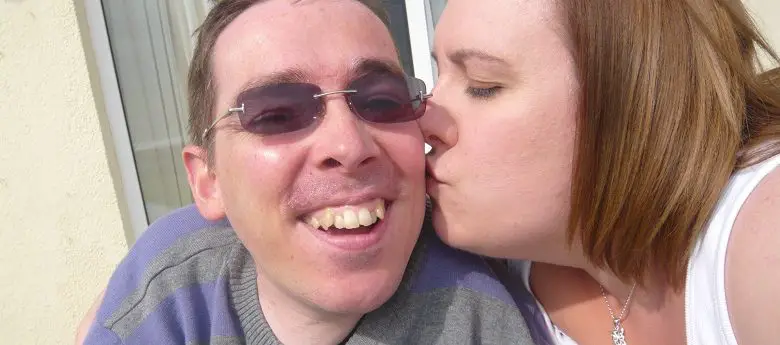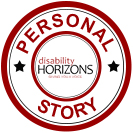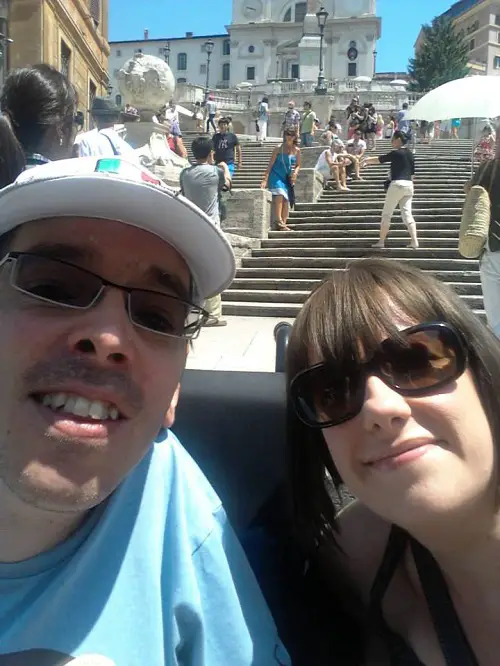
Proof that disability doesn’t mean love isn’t possible
Wading through disabled dating sites can become depressing. But there are success stories. Disability Horizons’ very own Chris Cusack is living proof of that. So, for love month, we’ve asked Chris to share his story to show you, and the world, that love is very much possible, no matter what your disability.
 My name is Chris Cusack and some of you may know me from my work with Disability Horizons. Others I am lucky to call friends. In my 30 years of work, I have tried my hand at many different things, including qualifying as a graduate member of the British Psychological Society.
My name is Chris Cusack and some of you may know me from my work with Disability Horizons. Others I am lucky to call friends. In my 30 years of work, I have tried my hand at many different things, including qualifying as a graduate member of the British Psychological Society.
I also have a neuromuscular condition called spinal muscular atrophy, which has caused severe progressive muscle weakness. I don’t carry this condition around like a wound, only an inconvenient reality that I try my best to adapt to.
2018 was an auspicious year for me in many ways. As well as marking my 50th birthday, I was also lucky enough to celebrate my 10th wedding anniversary with my beautiful wife Amy. My relationship with Amy is understandably the most significant relationship I have ever had, and has now spanned 12 years.
Last year was also the year that our long struggle to become parents finally started to go our way when Amy fell pregnant. But I’m rushing ahead here, so let me tell you how we met…
How it all began
12 and a half years ago I was a pretty typical single guy. My divorce from my first ill-conceived marriage had come through seven years earlier, and I had resumed the dating game about a year later.
My previous experience had made me quite cautious. Perhaps I was overly picky about what I was looking for. But my stubborn determination and need to make a connection kept me pushing forwards.
I had profiles on a number of different dating sites as a speculative way to meet people outside of the Darwinian setting of bars and clubs.
My policy on these sites was to always be open about my disability. I used photos that showed my chair and I mentioned my condition in my bio. I found that a great way to cut out time-wasters when it came to meeting up.
On one site, Whispers2U, I had written my profile after a few beers, so it wasn’t very sensible or even believable. But, unexpectedly, it did generate a fairly steady stream of emails, to which I replied with what was intended to be a humorous interview-style questionnaire.
The moment I saw Amy’s hilarious, bizarre and occasionally disturbing responses to it, I felt the strangest sense of connection. She was from Canada and had also gone through a divorce. She was interesting, smart and her reply made me want to get to know her better.
I soon learnt that she was in the process of tracing her family tree and planning a trip to London to pursue one branch of it. I suggested that, rather than staying at a hotel, she could stay with me and I would show her around and give her the benefit of local knowledge. She agreed, and before I knew it, she was here.
It was an amazing visit and the virtual connection between us very quickly became a real one. It was no time at all before Amy moved over to the UK and we began living together.

Adjusting to my disability
At first, Amy was very aware of how other people reacted to my disability. She noticed the stares, the condescending, well-meaning comments and the downright rude ones that I’m now oblivious to. She didn’t see my disability as a big deal and found it hard to understand why anyone else would. It left her exasperated and angry on a number of occasions.
She also found getting used to how much my disability appeared to affect me hard at first. My condition has changed my physicality, which means I can look frailer than I actually am. I could see the worry in her face each time I got sick. It took fighting off a few bad doses of the flu over a few years before she could see it for the inconvenience that it is, rather than anything life-threatening.
The big question
It was roughly a year into our relationship when I felt I knew Amy well enough to be certain that she was all I had ever wanted. So, I made the decision to propose.
I wanted it to be spontaneous, romantic and as memorable as it could be. But before I went ahead, there was something I felt I needed to do. I am lucky enough to get on extremely well with Amy’s parents and, even then, wanted to respect them enough to inform them of my intentions before I popped the question.
I was, of course, worried about their reaction to my disability. But when I made the rather shaky call to her father, I realised my worries were totally unfounded – he gave me his blessing straightaway.
I pulled as much of my savings out of my bank as I could and bought a ring, which I hid at the bottom of my bag on the back of my chair. I then arranged for us to have a trip to London, as we had on many other occasions. It was a beautiful sunny day and we wandered around Covent Garden before walking up The Strand towards the Savoy. As we were passing, I suggested that we popped in for a drink – for the experience, the selfie opportunity and just because!
We sat outside the Savoy Grill in reception sipping one of the most expensive glasses of wine I’ve ever drunk, making small talk in the most opulent surroundings. With all the calmness I could muster, I told Amy that I had something for her in my bag. When she reached in and found the ring box, I popped the question.
For a heart-stopping couple of seconds, Amy didn’t answer. But finally, she said simply yes. Maybe it was the applause from the staff nearby, or maybe just the emotion of the moment, but at that point I got a little carried away and asked if there was a spare table in the restaurant.
That night we sat amongst the wealthy and privileged, looking out at Rolls-Royces and Ferraris, feeling that, together, we could accomplish anything.

Bumps in the road
Things have not always been plain sailing though. We have the same issues that any other couples do, such as occasional communication problems or periodic money worries.
But I can’t deny that my disability has also caused issues. For example, when Amy first moved here and we were trying to blend our lives together, it took Amy a little while and a few arguments for her to become comfortable with having my carers around. It made Amy feel marginalised, like the house was not her home and she was merely a guest.
It was also difficult for the carers to get used to a new way of thinking, to accept that I was now part of a pair.
They needed time to realise that, despite the fact that they were responsible for my intimate personal care, there were now parts of my life that they weren’t privy to. For me, it meant I needed to tweak the level and visibility of care I had back to a degree that we were both happy with.
In my first marriage, care had become a contentious issue, leading to many blazing rows. For a while, I feared a similar thing happening here. If I could have talked to the man I was at the beginning of my relationship with Amy, I would have probably said to try and leave all my hang-ups in the ashes of my previous relationship, and listen more closely to what Amy was trying to tell me that she wanted.
Obviously, we survived the times when we argued. We tightened our belts when we had money worries and we both still try and see each other’s point of view. Now, 12 years later, after an eight-year battle to become parents, we are due to have our first child in a few short weeks.
I know and love Amy more than any other person on the planet and am as contented as anyone could hope to be.
My one final thought is – I wish this for each and every one of you too.
Just because you have a disability, DOESN’T mean love isn’t possible.
By Chris Cusack
More on Disability Horizons…